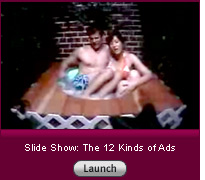
All excerpts taken from
slate.com. The image (left) contains the original presentation with YouTube example ads.
"... To me, the 12 formats serve equally well as a weapon of defense for the consumer under assault from endless advertising messages. It's like learning how a magic trick works: Once the secret's revealed, the trick loses all its power.
12 Kinds of Ads in the World Gunn's first format is the
"demo." This is a visual demonstration of a product's capabilities.
The second format is
"show the need or problem." First, you make it clear that something's not up to snuff in the consumer's life. Then, you introduce the remedy—which is, of course, the product you're selling.
The third format is a variation on showing the problem. This time, you employ a
"symbol, analogy, or exaggerated graphic" to represent the problem. In this Theraflu ad, for example, the problem is that a man's flu symptoms make him feel like an ogre. Thus, the ad portrays him as a literal ogre. When the man takes Theraflu, he returns to human form.
The fourth format is
"comparison." Here, the spotlight's on the claim that your product is superior to those of your competitors. In this Charles Schwab ad, a man complains that he hates his current stockbroker's hefty commissions. At the end of the spot, Schwab promises a better deal.
The fifth format is the
"exemplary story." These ads weave a narrative that helps illustrate the product's benefits. In Gunn's words, the key is to create "a situation where you'd use [the product] and be very glad for it."
The sixth format is
"benefit causes story." You conceive the ad back-to-front, by imagining a trail of events that might be caused by the product's benefit. In the example Gunn uses, a man on a safari screams when a lion charges him. It's then revealed, to the amusement of the man's friends (and also the viewer), that he's been looking through the powerful zoom lens of his Olympus camera. The lion is, in fact, hundreds of yards away.
The seventh format is "tell it"—also known as "presenter,"
"testimonial," or "A-tells-B." This can take the form of a kindly neighbor or best-friend spot ("Oh, I used to get arthritis when I gardened, too—here, try my Ouch-Be-Gone pills").
The eighth format is
"ongoing characters and celebrities." One big challenge when making an ad is to ensure that your brand "gets credit" for the spot. The viewer may remember the ad just fine and yet forget which brand it was for. The use of a recurring character, or celebrity, can help cement a brand's identity into the viewer's brain.
The ninth format is the
"symbol, analogy, or exaggerated graphic" demonstrating a benefit of the product.
The 10th format is
"associated user imagery": The advertiser showcases the type of people it hopes you'll associate with the product. Often these will be hip, funny, or good-looking people. But sometimes the associated users are goofy or geeky—it depends on the target market.
The 11th format is
"unique personality property." These spots highlight something indigenous to the product that will make it stand out. It could be the country of origin (a sports car boasting about its German engineering). It could be the product's unusual moniker ("With a name like Smucker's, it has to be good").
The 12th and final format is the
"parody or borrowed format." This is a popular approach these days, perhaps because pop-culture references have become our common language. Recent ads have parodied movies, TV shows—and even other ads.
..."



